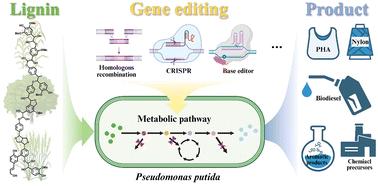Engineered Pseudomonas putida: a versatile chassis for lignin valorization†
IF 9.2
1区 化学
Q1 CHEMISTRY, MULTIDISCIPLINARY
引用次数: 0
Abstract
Lignin, a renewable aromatic polymer that is abundant in plant cell walls, represents a promising feedstock for producing high-value products. Lignin valorization offers a sustainable alternative to fossil-derived aromatics, playing a pivotal role in advancing the bioeconomy. However, the heterogeneous structure of lignin poses significant challenges for effective utilization. Pseudomonas putida has emerged as a premier microbial chassis for lignin bioconversion, owing to its innate capacity to catabolize aromatic compounds and its compatibility with advanced genetic engineering tools. This review explores the potential of P. putida as a versatile platform for lignin valorization, aligning with sustainable development goals. The unique metabolic and genetic advantages of P. putida in addressing lignin's structural complexity were summarized, along with a discussion of cutting-edge gene-editing technologies to enhance bioconversion efficiency. Furthermore, current advances, persistent challenges, and future directions were discussed by using P. putida chassis to maximize the synergy between synthetic biology and lignin valorization. By integrating current breakthroughs with emerging opportunities, this work underscores the transformative role of P. putida-driven biotechnologies in advancing a lignin-based circular bioeconomy.

工程恶臭假单胞菌:木质素增值的通用底盘†
木质素是一种富含植物细胞壁的可再生芳香族聚合物,是生产高价值产品的重要原料。木质素增值为化石来源的芳烃提供了一种可持续的替代品,在推进生物经济方面发挥着关键作用。然而,木质素的非均相结构对其有效利用提出了重大挑战。由于其固有的分解芳香族化合物的能力以及与先进的基因工程工具的兼容性,恶臭假单胞菌已成为木质素生物转化的首要微生物底盘。这篇综述探讨了恶臭杆菌作为木质素增值的多功能平台的潜力,与可持续发展目标保持一致。总结了恶臭杆菌在解决木质素结构复杂性方面的独特代谢和遗传优势,并讨论了提高生物转化效率的前沿基因编辑技术。此外,本文还讨论了利用恶臭杆菌底盘最大化合成生物学和木质素增值之间的协同作用的当前进展、持续挑战和未来方向。通过将当前的突破与新兴的机会相结合,这项工作强调了恶臭杆菌驱动的生物技术在推进基于木质素的循环生物经济中的变革性作用。
本文章由计算机程序翻译,如有差异,请以英文原文为准。
求助全文
约1分钟内获得全文
求助全文
来源期刊

Green Chemistry
化学-化学综合
CiteScore
16.10
自引率
7.10%
发文量
677
审稿时长
1.4 months
期刊介绍:
Green Chemistry is a journal that provides a unique forum for the publication of innovative research on the development of alternative green and sustainable technologies. The scope of Green Chemistry is based on the definition proposed by Anastas and Warner (Green Chemistry: Theory and Practice, P T Anastas and J C Warner, Oxford University Press, Oxford, 1998), which defines green chemistry as the utilisation of a set of principles that reduces or eliminates the use or generation of hazardous substances in the design, manufacture and application of chemical products. Green Chemistry aims to reduce the environmental impact of the chemical enterprise by developing a technology base that is inherently non-toxic to living things and the environment. The journal welcomes submissions on all aspects of research relating to this endeavor and publishes original and significant cutting-edge research that is likely to be of wide general appeal. For a work to be published, it must present a significant advance in green chemistry, including a comparison with existing methods and a demonstration of advantages over those methods.
 求助内容:
求助内容: 应助结果提醒方式:
应助结果提醒方式:


